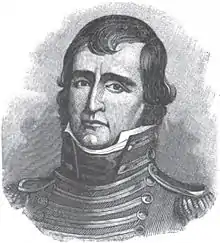Joseph Hamilton Daveiss
Major Joseph Hamilton Daveiss (/ˈdeɪvɪs/; March 4, 1774 – November 7, 1811) commanded the Dragoons of the Indiana Militia at the Battle of Tippecanoe, in which he was fatally wounded. Earlier, he had played a role in unsuccessful efforts to prove Aaron Burr guilty of betraying the country. Several places in the United States are named for Daveiss, but though he spelled his name "Daveiss", these places all have the spelling "Daviess".[1]
Joseph Hamilton Daveiss | |
|---|---|
 | |
| Birth name | Joseph Hamilton Daveiss |
| Born | March 4, 1774 Bedford County, Virginia |
| Died | November 7, 1811 (aged 37) |
| Service/ | United States Army Indiana Territory, Militia |
| Years of service | 1811 |
| Commands held | Dragoon Reserve |
| Spouse(s) | Nancy |
Early life
Daveiss was born on March 4, 1774, in Bedford County, Virginia. He moved at a young age with his parents to Kentucky, eventually settling near Danville, Kentucky. Admitted to the Kentucky bar in 1795, he appeared in court dressed as a backwoodsman. He served as a second in a duel in 1799, and was for a time a fugitive. Daveiss eventually defended his principal in court, and achieved an acquittal.
Career as lawyer
Daveiss is said to have been the first lawyer west of the Appalachian Mountains to argue a case before the United States Supreme Court. He married Chief Justice John Marshall's sister Nancy, and returned to Kentucky.
Daveiss served as United States Attorney for Kentucky. He has been described as a "Kentucky Federalist". In February and March 1806, he wrote President Thomas Jefferson several letters warning him of possible conspiratorial activities by Aaron Burr, who at that point was a former vice president of the United States. Daveiss' July 14 letter to Jefferson stated flatly that Burr planned to provoke a rebellion in Spanish-held parts of the West in order to join them to areas in the Southwest to form an independent nation under his rule. Similar accusations were appearing against local Democratic-Republicans in a Frankfort, Kentucky newspaper, Western World, and Jefferson dismissed Daveiss' accusations against Burr, a Democratic-Republican, as politically motivated.
In 1806, Daveiss brought treason charges against Burr in Kentucky. The charges were, however, dismissed thanks to the help of Burr's attorney, Henry Clay. Burr faced federal charges of treason in 1807 but was acquitted at trial.
Battle of Tippecanoe
In 1811, Daveiss volunteered to serve in the Indiana militia, answering Governor Harrison's call for troops to march against Tecumseh's village at Prophetstown. He was placed in command of two companies of dragoons, and all the cavalry in Harrison's army.
On the night of November 6, 1811, Harrison's army made camp near Prophetstown. Major Daveiss' dragoons occupied a position in the rear of the left flank. The dragoons were instructed to fight dismounted, with pistols, as a reserve in the event of a night attack. When the Indians attacked early the next morning, Major Daveiss advanced toward the heaviest fire with a small detachment. He was driven back, and mortally wounded in the process. He died soon after.
At the time of the Battle of Tippecanoe, Daveiss was serving as the eighth Grand Master of Masons of the Grand Lodge of Kentucky. He was a member of Lexington Lodge #1.
Places named after Daveiss
References
- Original letter from Daveiss at Vincennes Lodge No. 1.
- The Register of the Kentucky State Historical Society, Volume 1. Kentucky State Historical Society. 1903. pp. 35.
- Upham, Warren (1920). Minnesota Geographic Names: Their Origin and Historic Significance. Minnesota Historical Society. p. 186.
Further reading
- Rothert, Otto A. (October 1931). "The Grave of Joseph Hamilton Daveiss". Filson Club History Quarterly. 5 (4). Archived from the original on 2012-04-25. Retrieved 2011-11-29.